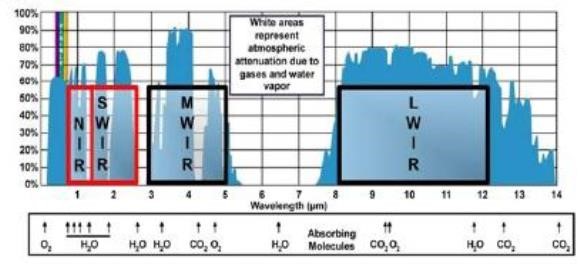News
What is SWIR Imaging?
23rd Mar, 2020
Short-wave Infrared imaging (SWIR) is an advanced method of producing images based on radiation in the region of the electromagnetic spectrum invisible to the naked eye.
Mid- and long-wave infrared (MWIR/LWIR) spectral bands will sense thermal emissions from all objects with a temperature above absolute zero (0K), making it possible for thermographic cameras to obtain images based on localized temperature variations. Short-wave infrared (SWIR) imaging is distinct in that the radiation of interest is closer to the visible spectrum but will still enable temperature sensing above typically 100 degrees C. By extending into wavebands that are invisible to both conventional optics and MWIR/LWIR thermal imaging, SWIR cameras have occupied a unique spectroscopic niche in industrial and scientific markets.
In this article, we will explore some of the basic principles and applications of SWIR imaging in more detail and how SWIR cameras have occupied a unique spectroscopic niche in industrial and scientific markets.
Understanding SWIR Imaging: The Basics
IR radiation extends from the red edge of the visible spectrum of light across a wavelength range of approximately 700 – 1,000,000 nanometres (nm). Within that spectrum are four distinct wavebands: near-infrared (NIR), SWIR, MWIR, and LWIR. How objects emit or reflect IR radiation is indicative of various physicochemical and thermal properties. For instance, materials exhibit characteristic SWIR absorption/reflection characteristics based on their distinct chemistries, enabling SWIR imaging to detect specific materials remotely.

Unlike MWIR/LWIR, SWIR imaging does not rely on the inherent emissivity of objects, hence it is not typically characterized as thermal energy. Nor is SWIR imaging inhibited by ambient working conditions that render visible light-based optics unsuitable. There are numerous benefits to these properties that are increasingly exploited across a wide market cross-section using cameras based on cooled indium gallium arsenide (InGaAs) focal plane arrays.SWIR refers to the portion of IR radiation adjacent to NIR, occupying a nominal wavelength range of 1,400 – 3,000 nm. We describe these wavelength ranges as approximations as there is no definitive standard of where each waveband separates. Some classifications even consider SWIR as an extension of the NIR band.
InGaAs focal plane cameras comprise an epitaxy grown InGaAs semiconductor bump bonded to a 2-dimensional readout integrated circuit (ROIC). InGaAs absorbs IR light invisible to silicon thanks to a wider bandgap and converts incident light into electrons digitized by the ROIC and the camera electronics. InGaAs materials have a relatively high dark current compared to silicon-based devices. Cooling is subsequently essential to reduce dark noise and improve the low light level capabilities of InGaAs focal plane arrays for SWIR imaging.
Key Applications of SWIR Imaging
SWIR imaging with cooled InGaAs focal plane arrays offers unprecedented resolution with extremely high contrast, allowing researchers and process engineers to visualize what was previously invisible. Using a SWIR camera, it is easy to distinguish between regions that are chromatically similar or to penetrate opaque materials non-invasively. A short selection of application of SWIR imaging include:
- Astronomy
- Active imaging
- Enhanced vision assistance in misty conditions
- Free space optical communication
- Hyperspectral imaging
- Industrial sorting
- Laser beam profiling
- Small animal imaging
- Solar cell inspection
- Spectroscopy
- Range finding
SWIR Imaging with Photonics Science
Photonics Science is one of the industry-leading manufacturers and suppliers of high-precision SWIR cameras for research and production-scale applications alike. Our tailored product range offers the best-in-class all-round performance for SWIR imaging applications. These include:
If you would like to learn more about our robust SWIR imaging product range, simply contact a member of the Photonics Science team today.

